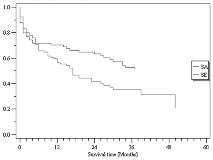STATUS EPILEPTICUS IS ASSOCIATED WITH INCREASED LONG-TERM MORTALITY IN PATIENTS WITH CEREBROVASCULAR DISEASE
Abstract number :
C.03
Submission category :
Year :
2003
Submission ID :
1607
Source :
www.aesnet.org
Presentation date :
12/6/2003 12:00:00 AM
Published date :
Dec 1, 2003, 06:00 AM
Authors :
Felix Rosenow, Niki Katsarou, Justine Rochon, Sarah Fenselau, Wolfgang H. Oertel, Mathias Vescovi, Tobias Back, Hajo M. Hamer, Susanne Knake Epilepsy-Center - Department of Neurology, Philipps-University Marburg, Marburg, Hessen, Germany; Institute for Me
The only study investigating long-term (over 1 year) mortality after status epilepticus (SE) recently reported age, status duration of over 24 hours, acute symptomatic etiology and myoclonic SE causes by hypoxic brain injury as factors predictive of a higher long term mortality. The long-term mortality of patients with idiopathic/cryptogenic SE was not altered as compared to the general population. The authors concluded that the SE itself did not contribute to mortality. On the other hand a study comparing patients with stroke alone, stroke and SE, and SE alone demonstrated a statistically significant synergistic effect of SE and CVA on shot-term mortality. We investigated whether cerebrovascular disease (CVD) and SE have synergistic effects on long-term mortality by comparing patients with acute stroke (AS) to patients with a first episode of SE caused by CVD.
We compared 103 patients with SE of vascular origin (SE-group) with 74 patients with an acute stroke (AS-group). Patients were followed over a minimum of 36 month. Kaplan-Meier survival analysis was used to compare the groups. Subsequenty the following risk factors were considered in a multiple regression analysis: age, kind of cerebrovascular disease (AS, ICB, SAE or ICB caused by AVM), unilateral vs. bilateral vascular disease.
The long-term mortality was 47.3% in the AS group and 60.2% in the SE group even though the average age was lower in the SE-group (69 vs. 73yrs). This difference was significant using Kaplan-Meier survival analysis (p=0.026, fig. 1). Bilateral cerecrovascular disease (CVD) was more frequent in the SE-group (19 vs 7%). Both patients with an ICB caused by an AVM were in the SE-group and died. Multiple regression anaysis identified the following significant risk factors for indreased mortality: Age, bilateral CVD, ICB caused by AVM. Group was not an independant risk factor.
Patients with a SE of vascular origin have a significantly higher long term mortality than patients admmitted for AS. Bilateral CVD and an ICB caused by an AVM are independant risk factors of increased mortality and were highly over-represented in the SE-group, indicating that they may be risk factors for an SE in patients with CVD. Futhermore, age but not SE itself were significant independent risk factors for increased mortality.[figure1]
[Supported by: The Epilepsy Center Marburg received a research grant to employ NK by the Verein zur Erforschung der Epidemiologie der Epilepsien e.V., Germany; FR was partially supported by the Ulran-Professorship for Neurology/Epileptology]
